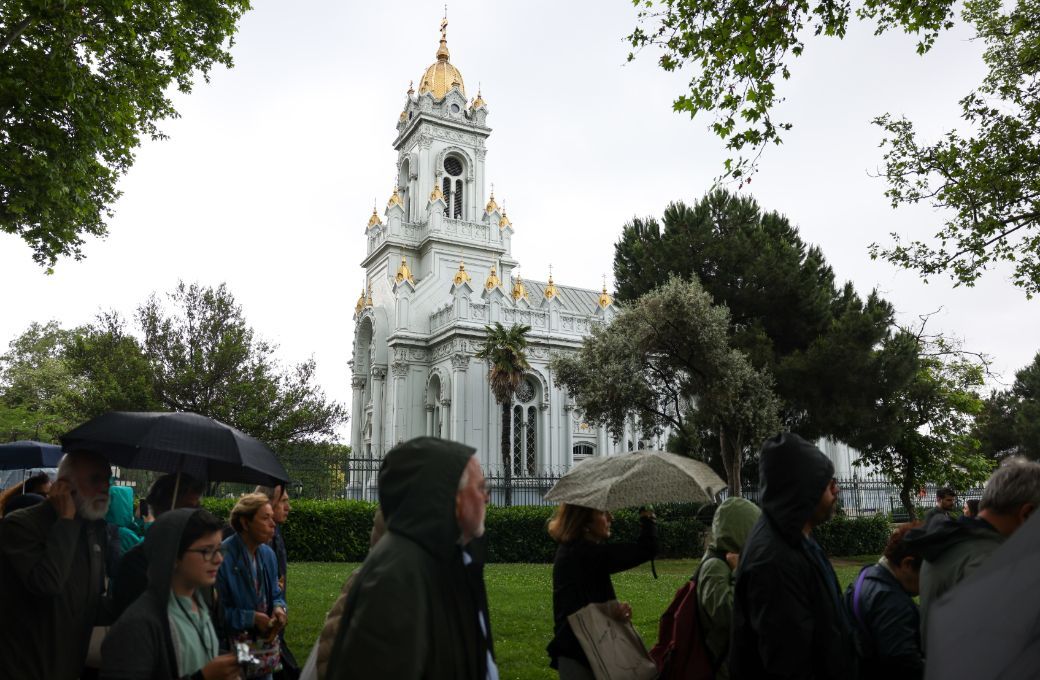“Music Route” is a popular fixture at the Istanbul Music Festival. There are two elements, the music and the route, and one is not more important than the other. For a discerning (and nosy) crowd of locals, the day affords the chance to explore churches and other buildings closed to view for the rest of the year, like the annual Open House weekend in London.
This year, the Route criss-crossed and climbed the narrow streets of Balat, tucked away on the western side of the Golden Horn. There are no Starbucks here. Like much of Istanbul, it’s a piece of living archaeology. In its pastel-painted houses and countless places of worship, the city’s Jewish and Orthodox communities have made their home at points in history. Unseasonal showers only sharpened the scents of fresh garlic, cheese pastries and overripe strawberries from market stalls. A pickled walnut had made a bid for freedom and was borne away on a guttering stream.
While Mass was being chanted at the Ecumenical Patriarchate cathedral, the damp raggle-taggle train of musical pilgrims made its way to the nearby St Demetrios Greek Orthodox Church for a cello-and-guitar recital by a photogenic young Italian duo. A Latin-themed programme showed off the languorous cantabile of cellist Erica Piccotti. Her tango technique was probably more refined and Classical than Piazzolla had in mind when writing Adios Noníno, but it served to harmonise the cognitive dissonance between the music’s erotic charge and the noble countenances of the icons gazing down upon us.
The youthful duo are an established pair, and they play off one another with complete assurance. Even while the melodic spotlight fell on Piccotti through a sequence of Albéniz, de Falla and Granados transcriptions, guitarist GIan Marco Ciampa would step forward now and then with a deftly timed pay-off, before launching into Piazzolla’s Escualo like a dancer taking his partner by surprise for the final number.

Half an hour later, we were down by the shore of the Bosphorus inside the “Iron Church” dedicated to St Stephen, so called because it was cast in prefabricated parts and shipped down the Danube from Austria to provide a spiritual home to Istanbul’s Bulgarian Orthodox community at the end of the 19th century. The gilded interior belies expectations of austerity within. Indeed there could hardly have been a more fitting venue, aesthetically or acoustically, for the harpist Güneş Hızlılar.
Like Ciampa and Piccotti, Hızlılar is young but a fully formed artist who radiates charisma. Her recital sprang any number of surprises, not least for being played out of the printed sequence; she explained the new order in Turkish, but it was all Greek to me. The French accent of Caplet’s Divertissement was unmistakable all the same; so to the manneristic flourishes of Scarlatti’s Sonata K209, and the Tristan chord opening Liszt’s transcription of Le Rossignol (retranscribed for harp by Henriette Renié). In Hızlılar’s hands, the romantic melancholy of Alabyev’s original song was counterbalanced by intimations of the mechanised nightingale from Stravinsky’s Chinese opera.
I could have listened to her all day, but a stiff climb up through Balat took us to the gates of the Fener Greek Orthodox School, perched on a magnificent vantage point over the Bosphorus. With its dark red brick, drab cream walls, tarmac playground and general air of functional severity, the school would not look out of place in any English city, at least until you step into its assembly hall. Set into the ceiling, portraits of Herodotus, Demosthenes, Aristotle and those others who built what we still call civilisation. Around us on murals, turning points in Western history: Pericles and Alexander addressing their troops, Saint Paul his disciples. Up on the dais, more icons of Church Fathers: another extraordinary harmonisation of trans-historical ideas, no less than the Bach-to-tango programme of the Spectrum Saxophone Quartet.
This German-Turkish quartet barely drew breath in a high-energy, 45-minute set that kicked off with the quick movements of Bach’s Italian Concerto and kept up the pace with the pumping bass of Thierry Escaich’s Tango Virtuoso. Unfamiliar with the saxophone quartet repertory, I was most taken with Ciudades, a triptych by the Dutch composer Guillermo Lago (aka Willem van Merwijk, b.1960). The suite takes us from a street market in Addis Ababa to a lonely night in Sarajevo, and finally a Moorish dance in an imaginary, modern-medieval Cordoba. The Spectrum Quartet kept it tight as a drum, and built the disparate episodes of Gerald Preinfalk’s Twintango to a final pitch of intensity hardly becoming an Orthodox school hall. But that’s the fun of Music Route.
Peter's press trip was funded by the Istanbul Music Festival.


